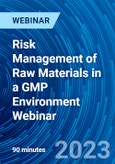Risk management of raw materials in a cGMP environment is an area that is often overlooked as a Company develops new products. Depending on the product being developed, e.g., tablets and capsules vs. biotechnology products, as few as fifteen to twenty raw materials or as many as sixty need to be sourced and accepted before the process can be moved from initiation through completion. This live, interactive presentation will extensively review this area. It will also delve into the renewed issue of microbial and endotoxin contamination of these raw materials and why the FDA, EMA and Health Canada have recently focused on them.
This live, interactive training webinar will also examine a variety of the issues surrounding raw materials including what materials should be tested and to what extent during Phase 1, 2 and 3. It will cover testing requirements during each Phase and what may be optional until the product moves to its next Phase. It will determine what options exist - even within a Phase 2 or Phase 3 testing framework. It will discuss compendial vs. non-compendial testing and how to respond when no method is available. The presentation will also discuss how a 90 percent vs. a 90.0 percent minimum purity analysis can delay your initiation of testing. Further, it will consider packaging and storage requirements and their impact on incoming materials to include both raw materials and API.
The live training webinar will explore the number of lots required to be tested before reduced testing might occur and why some Companies don’t accept this path. It will also review the use of individual samples vs. composite samples for testing. It will also consider the option of using the square root of “n” plus 1 vs the American Society for Quality (ASQ) methodology as alternative sampling methodologies.
The objective of this live, interactive Executive Conference Corporation webinar is to explore raw materials in a cGMP environment, their various regulatory requirements and how they may affect the timeline of meeting the release date of your Company’s products. Please plan to bring additional personnel to the webinar to obtain cross-Department training.
Webinar Takeaway
- How to develop an overall strategy for testing raw materials in a Phase 1 through Phase 3 environment.
- What raw material testing is required during each Phase of clinical trials.
- What your Certificate of Analysis (COA) may and may not tell you.
- How to manage non-compendial testing.
- Issues with small vs. large molecules.
- Types of raw materials and their concerns to the user.
- Packaging and storage requirements and their impact on in-coming materials
- Impact of raw materials receipt in the timely production of a product.
- Review of validation criteria and recommendations for satisfying each as part of a microbiological validation.
- What is the single largest used raw material in large molecule production.
- Sources of analyses assistance for raw materials.
- Initiation of additional testing - when???
- Observe Warning Letters related to Raw Material issues.
Speakers

Dr Barry A. Friedman, Ph.D,
Consultant ,
Cambrex Bio SciencesDr. Friedman possesses over 30 years of industrial managerial experience in various aspects of biopharmaceuticals and medical devices to include regulatory compliance, expert witness testimony, GLP/GMP, quality control, auditing, sterility assurance, microbiological/analytical validations and fermentation technology.
Prior to becoming an independent consultant, Dr. Friedman was associated with Cambrex Bio Sciences, a contract manufacturer of GMP bulk biopharmaceuticals located in Baltimore, Maryland. As the Director of Quality Control, he managed a multi-shift Department of thirty one individuals involved in client management, the receipt and testing of raw materials, environmental monitoring and microbiology, analytical chemistry and QC compliance for the production of Phase 1, 2, 3 and commercial products manufactured from bacteria, yeast and mammalian cells. In this capacity, Dr Friedman enjoyed many client and regulatory interactions, both domestic and international.
Prior to 2000, Dr. Friedman was the Laboratory Director for Chesapeake Biological Laboratories, a contract Aseptic Fill n’ Finish manufacturer located in Baltimore, Maryland. In addition to the professional history listed above, other associations have included W.R. Grace, Sigma Chemical Co., Sherwood Medical, Becton Dickinson, American Cyanamid and Union Carbide.
Dr. Friedman received his B.S. degree in Microbiology from Ohio State University, his M.S. from Michigan State University in Microbial Genetics, and his PhD from Ohio State University in Microbiology.
Who Should Attend
- Incoming Materials
- Quality Control
- Quality Assurance
- Regulatory Compliance
- Manufacturing
- Validation
- Research & Development
- Project Management









